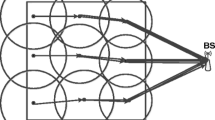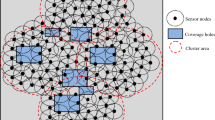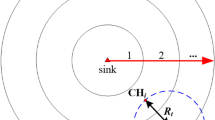Abstract
The problem of energy efficiency in cognitive radio sensor networks (CRSN) is mainly caused by the limited energy of sensor nodes and other channel-related operations for data transmission. The unequal clustering method should be considered for balancing the energy consumption among the cluster heads (CHs) for prolonging the network lifetime. The CH selection should consider the number of accessible free channels for efficient channel assignment. To improve fairness, the channel assignment problem should consider energy consumption among the cluster members. Furthermore, the relay metric for the selection of the best next-hop should consider the stability of the link for improving the transmission time. The CH rotation for cluster maintenance should be energy and spectrum aware. With regard to the above objectives, this paper proposes an energy and spectrum aware unequal clustering (ESAUC) protocol that jointly overcomes the limitations of energy and spectrum for maximizing the lifetime of CRSN. Our proposed ESAUC protocol improves fairness by achieving residual energy balance among the sensor nodes and enhances the network lifetime by reducing the overall energy consumption. Deep Belief Networks algorithm is exploited to predict the spectrum holes. ESAUC improves the stability of the cluster by optimally adjusting the number of common channels. ESAUC uses a CogAODV based routing mechanism to perform inter-cluster forwarding. Simulation results show that the proposed scheme outperforms the existing CRSN clustering algorithms in terms of residual energy, Network Lifetime, secondary user–primary user Interference Ratio, Route Discovery Frequency, throughput, Packet Delivery Ratio, and end-to-end delay.

























Similar content being viewed by others
References
Haykin S (2005) Cognitive radio: brain-empowered wireless communications. IEEE J Sel Areas Commun 23:201–220. https://doi.org/10.1109/JSAC.2004.839380
Luo H, Huang Z, Zhu T (2015) A survey on spectrum utilization in wireless sensor networks. J Sens 2015:1–13. https://doi.org/10.1155/2015/624610
Akan O, Karli O, Ergul O (2009) Cognitive radio sensor networks. IEEE Netw 23:34–40. https://doi.org/10.1109/MNET.2009.5191144
Joshi G, Nam S, Kim S, Joshi GP, Nam SY, Kim SW (2013) Cognitive radio wireless sensor networks: applications, challenges and research trends. Sensors 13:11196–11228. https://doi.org/10.3390/s130911196
Ahmad A, Ahmad S, Rehmani MH, Hassan NU (2015) A survey on radio resource allocation in cognitive radio sensor networks. IEEE Commun Surv Tutor 17:888–917. https://doi.org/10.1109/COMST.2015.2401597
Yu J, Qi Y, Wang G, Guo Q, Gu X (2011) An energy-aware distributed unequal clustering protocol for wireless sensor networks. Int J Distrib Sens Netw 7:202145. https://doi.org/10.1155/2011/202145
Stephan T, Joseph KS (2016) PSO assisted OLSR routing for cognitive radio vehicular sensor networks. In: Proceedings of the international conference on informatics and analytics—ICIA-16. https://doi.org/10.1145/2980258.2980457
Kang X, Liang Y-C, Nallanathan A, Garg HK, Zhang R (2009) Optimal power allocation for fading channels in cognitive radio networks: ergodic capacity and outage capacity. IEEE Trans Wirel Commun 8:940–950. https://doi.org/10.1109/TWC.2009.071448
Van Huynh V, Nguyen HS, Hoc LTT, Nguyen TS, Voznak M (2019) Optimization issues for data rate in energy harvesting relay-enabled cognitive sensor networks. Comput Netw. https://doi.org/10.1016/j.comnet.2019.04.012
Xu C, Song C, Zeng P, Yu H (2018) Secure resource allocation for energy harvesting cognitive radio sensor networks without and with cooperative jamming. Comput Netw. https://doi.org/10.1016/j.comnet.2018.05.026
Lo BF (2011) A survey of common control channel design in cognitive radio networks. Phys Commun 4:26–39. https://doi.org/10.1016/J.PHYCOM.2010.12.004
Stephan T, Joseph KS (2016) Cognitive radio assisted OLSR routing for vehicular sensor networks. Procedia Comput Sci 89:271–282. https://doi.org/10.1016/j.procs.2016.06.058
Al-Turjman F (2019) Cognitive routing protocol for disaster-inspired Internet of Things. Future Gener Comput Syst 92:1103–1115. https://doi.org/10.1016/j.future.2017.03.014
Al-Turjman F (2017) Cognitive-node architecture and a deployment strategy for the future WSNs. Mob Netw Appl 24(5):1663–1681. https://doi.org/10.1007/s11036-017-0891-0
Ullah Z, Al-Turjman F, Mostarda L (2020) Cognition in UAV-aided 5G and beyond communications: a survey. IEEE Trans Cogn Commun Netw. https://doi.org/10.1109/tccn.2020.2968311
Stephan T, Suresh Joseph K (2018) Particle swarm optimization-based energy efficient channel assignment technique for clustered cognitive radio sensor networks. Comput J. https://doi.org/10.1093/comjnl/bxx119
Ahmed E, Gani A, Abolfazli S, Yao LJ, Khan SU (2016) Channel assignment algorithms in cognitive radio networks: taxonomy, open issues, and challenges. IEEE Commun Surv Tutor 18:795–823. https://doi.org/10.1109/COMST.2014.2363082
Cui Y, Jing Xj, Sun S, Wang X, Cheng D, Huang H (2015) Deep learning based primary user classification in cognitive radios. In: 2015 15th International symposium on communications and information technologies (ISCIT). pp 165–168. https://doi.org/10.1109/iscit.2015.7458333
Heinzelman WB, Chandrakasan AP, Balakrishnan H (2002) An application-specific protocol architecture for wireless microsensor networks. IEEE Trans Wirel Commun 1:660–670. https://doi.org/10.1109/TWC.2002.804190
Younis O, Fahmy S (2004) HEED: a hybrid, energy-efficient, distributed clustering approach for ad hoc sensor networks. IEEE Trans Mob Comput 3:366–379. https://doi.org/10.1109/TMC.2004.41
Gupta V, Pandey R (2016) An improved energy aware distributed unequal clustering protocol for heterogeneous wireless sensor networks. Eng Sci Technol Int J 19:1050–1058. https://doi.org/10.1016/J.JESTCH.2015.12.015
Bradonjic M, Lazos L (2012) Graph-based criteria for spectrum-aware clustering in cognitive radio networks. Ad Hoc Netw 10:75–94. https://doi.org/10.1016/J.ADHOC.2011.05.009
Eletreby R, Elsayed H, Khairy M (2014) CogLEACH: A spectrum aware clustering protocol for cognitive radio sensor networks. In: Proceedings of 9th international conference on cognitive radio oriented wireless networks, ICST, 2014. https://doi.org/10.4108/icst.crowncom.2014.255370
Zhang H, Zhang Z, Dai H, Yin R, Chen X (2011) Distributed spectrum-aware clustering in cognitive radio sensor networks. In: 2011 IEEE global telecommunication conference—GLOBECOM 2011, IEEE. pp 1–6. https://doi.org/10.1109/glocom.2011.6134296
Shah GA, Alagoz F, Fadel EA, Akan OB (2014) A spectrum-aware clustering for efficient multimedia routing in cognitive radio sensor networks. IEEE Trans Veh Technol 63:3369–3380. https://doi.org/10.1109/TVT.2014.2300141
Li C, Ye M, Chen G, Wu J (n.d.) An energy-efficient unequal clustering mechanism for wireless sensor networks. In: IEEE international conference on mobile adhoc sensor system 2005., IEEE. pp 597–604. https://doi.org/10.1109/mahss.2005.1542849
Pei E, Han H, Sun Z, Shen B, Zhang T (2015) LEAUCH: low-energy adaptive uneven clustering hierarchy for cognitive radio sensor network. EURASIP J Wirel Commun Netw 2015:122. https://doi.org/10.1186/s13638-015-0354-x
Motamedi A, Bahai A (2007) MAC protocol design for spectrum-agile wireless networks: stochastic control approach. In: 2007 2nd IEEE international symposium new frontiers in dynamic spectrum access networks, IEEE. pp 448–451. https://doi.org/10.1109/dyspan.2007.65
Chen Yunxia, Zhao Qing (2005) On the lifetime of wireless sensor networks. IEEE Commun Lett 9:976–978. https://doi.org/10.1109/LCOMM.2005.11010
Li X, Wang D, McNair J, Chen J (2011) Residual energy aware channel assignment in cognitive radio sensor networks. In: 2011 IEEE wireless communication network conference, IEEE. pp 398–403. https://doi.org/10.1109/wcnc.2011.5779196
Liang Z, Feng S, Zhao D, Shen XS (2011) Delay performance analysis for supporting real-time traffic in a cognitive radio sensor network. IEEE Trans Wirel Commun 10:325–335. https://doi.org/10.1109/TWC.2010.111910.100804
Bicen AO, Gungor VC, Akan OB (2012) Delay-sensitive and multimedia communication in cognitive radio sensor networks. Ad Hoc Netw 10:816–830. https://doi.org/10.1016/J.ADHOC.2011.01.021
Lin S-C, Chen K-C (2014) Improving spectrum efficiency via in-network computations in cognitive radio sensor networks. IEEE Trans Wirel Commun 13:1222–1234. https://doi.org/10.1109/TWC.2014.011514.121905
Quang PTA, Kim D-S (2014) Throughput-aware routing for industrial sensor networks: application to ISA100.11a. IEEE Trans Ind Inform 10:351–363. https://doi.org/10.1109/tii.2013.2255617
Spachos P, Hantzinakos D (2014) Scalable dynamic routing protocol for cognitive radio sensor networks. IEEE Sens J 14:2257–2266. https://doi.org/10.1109/JSEN.2014.2309138
Pei Y, Liang Y-C, Teh KC, Li KH (2011) Energy-efficient design of sequential channel sensing in cognitive radio networks: optimal sensing strategy, power allocation, and sensing order. IEEE J Sel Areas Commun 29:1648–1659. https://doi.org/10.1109/JSAC.2011.110914
Han JeongAe (2011) WhaSookJeon, dong geunjeong, energy-efficient channel management scheme for cognitive radio sensor networks. IEEE Trans Veh Technol 60:1905–1910. https://doi.org/10.1109/TVT.2011.2128355
Bhuvaneswari PTV, Vaidehi V, Saranya MA (2010) Distance based transmission power control scheme for indoor wireless sensor network. Springer, Berlin, pp 207–222. https://doi.org/10.1007/978-3-642-17697-5_11
Jovanovic MD, Djordjevic GL (2007) TFMAC: Multi-channel MAC protocol for wireless sensor networks. In: 2007 8th international conference telecommunication modern satellite cable broadcasting service, IEEE. pp 23–26. https://doi.org/10.1109/telsks.2007.4375929
Liu Y, Liang J, Xiao N, Yuan X, Zhang Z, Hu M, Hu Y (2017) Adaptive double threshold energy detection based on Markov model for cognitive radio. PLoS ONE 12:e0177625. https://doi.org/10.1371/journal.pone.0177625
Heinzelman WR, Chandrakasan A, Balakrishnan H (n.d.) Energy-efficient communication protocol for wireless microsensor networks. In: Proceedings of 33rd annual hawaii international conference on system science, IEEE Computer Society. p 10. https://doi.org/10.1109/hicss.2000.926982
Agarwal S, De S (2015) Impact of channel switching in energy constrained cognitive radio networks. IEEE Commun Lett 19:977–980. https://doi.org/10.1109/LCOMM.2015.2416334
Huang X, Lu D, Li P, Fang Y (2011) Coolest path: spectrum mobility aware routing metrics in cognitive ad hoc networks. In: 2011 31st international conference distributor computer systems, IEEE. pp 182–191. https://doi.org/10.1109/icdcs.2011.34
Osiadacz AJ (1989) Multiple criteria optimization; theory, computation, and application, Ralph E. Steuer, Wiley Series in Probability and Mathematical Statistics—Applied, Wiley, 1986, No. of pages 546, Price f5 1.40, $77.10. Optim Control Appl Methods 10:89–90. https://doi.org/10.1002/oca.4660100109
Kim W, Oh SY, Gerla M, Lee KC (2011) CoRoute: A new cognitive anypath vehicular routing protocol. In: 2011 7th international wireless communication mobile computing conference, IEEE. pp 766–771. https://doi.org/10.1109/iwcmc.2011.5982643
Saleem Y, Yau K-LA, Mohamad H, Ramli N, Rehmani MH (2015) SMART: A SpectruM-Aware ClusteR-based rouTing scheme for distributed cognitive radio networks. Comput Netw 91:196–224. https://doi.org/10.1016/J.COMNET.2015.08.019
Hoyhtya M, Pollin S, Mammela A (2010) Classification-based predictive channel selection for cognitive radios. In: 2010 IEEE international conference communication, IEEE. pp 1–6. https://doi.org/10.1109/ICC.2010.5501787
Zhang X, Yang S, Srivastava G, Chen M-Y, Cheng X (2020) Hybridization of cognitive computing for food services. Appl Soft Comput 89:106051. https://doi.org/10.1016/j.asoc.2019.106051
Author information
Authors and Affiliations
Corresponding author
Additional information
Publisher's Note
Springer Nature remains neutral with regard to jurisdictional claims in published maps and institutional affiliations.
Appendix
Appendix
Illustrations
Illustration for WCSE metric described in Sect. 4.1.
Figure 26 depicts the PU occupancy over six different channels, (n1, n2, n3, n4, n5 and n6) which is measured over forty four sampling intervals.
The estimated CS values are shown in Table 12.
Rights and permissions
About this article
Cite this article
Stephan, T., Al-Turjman, F., K, S. et al. Energy and spectrum aware unequal clustering with deep learning based primary user classification in cognitive radio sensor networks. Int. J. Mach. Learn. & Cyber. 12, 3261–3294 (2021). https://doi.org/10.1007/s13042-020-01154-y
Received:
Accepted:
Published:
Issue Date:
DOI: https://doi.org/10.1007/s13042-020-01154-y





